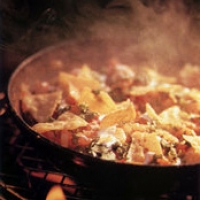
Ingredients
- First assemble all the ingredients. Cut the main item into a appropriate size. Trim away the fat, silverskin, and gristle from meats. For poultry and fillets of fish, remove the skin and bones. Pound or butterfly the meats to achieve an even thickness.
- vegetables and fruits are generally sliced, but this should be a decision made with respect to the nature of the food itself. For instance, you would certainly slice or chunk pineapple before sautéing it, but you may not need to do so with small button mushrooms.
- marinades, stuffing, or seasonings may be required by specific recipes. marinades should be allowed a sufficient amount of time to add the correct degree of flavor. Stuffing must be properly prepared, allowed to cool if necessary, then incorporated correctly and secured so that they do not escape during cooking.
- Dredging or dusting the item with flour is another common advance preparation technique. This is generally recommended for meat cut into strips and for chicken and fish. Dusting is optional, otherwise, and many chefs feel that it is not always desirable. If you wish, seasoning can be added to the flour. if it is not, it is generally a good idea to season the food lightly with salt, pepper, or other items just prior to sautéing.
- The cooking medium must be able to reach relatively high temperatures without breaking down or smoking. clarified butter, neutral-flavored oil, olive oil, or rendered fats such as bacon, goose fat, or lard are often used.
- A base sauce (demi-glace, just lie, essences, broths, or coulis, for instance) is usually necessary. There are a number of possible ingredients you may need to have on hand to flavor or finish the sauce. wine, stock, cognac or liqueur, fortified wine, or water is often used to deglaze the pan.
- Additional aromatic ingredients, such as shallots, mushrooms, capers, tomatoes, or peppers might be required. butter may be used to finish the sauce; it should be whole butter, diced and either chilled or softened to room temperature.
- Once you have all the ingredients prepared, assemble all the necessary equipments. A saute pan may be referred to as a "sauteuse" or "sautoir". They also variously are referred to, depending upon the size, shape, and material used to make the pan, as griswolds (cast iron), bi-metals (copper lined with tin or stainless steel), or rondeaus (if they are quite large).
- Bear in mind that certain materials are better at conducting heat quickly with quick reaction to changes in temperature, while others offer a more constant heat and does not react as quickly. There are benefits to both types of pans, and you will learn quickly which pan works best in which situation and with which food as you get used to sautéing.
- The quantity of food you will be sautéing should be taken into account when selecting an appropriate pan. It is important that the pan be of an appropriate size, to avoid overcrowding. If too much is put in the pan, the pan's temperature will drop quickly and a good crust will not form on the food. Equally important, the pan must not be too large as this can cause the drippings to scorch, rendering them unsuitable for the sauce.
- A selection of small tools, holding containers, and serving pieces are also necessary. Spatulas, tongs, spoons (slotted and solid metal spoons, wooden spoons, and tasting spoons), sizzler platters or sheet pans, bain-maries and steam tables for holding sauce, and strainer should be close at hand.
Description
Just An Educational Tidbit For Us Up And Coming Cooks.



Join Recipe Bridge
Sign up with the click of a button
Signup with Facebook Sign in with Twitter